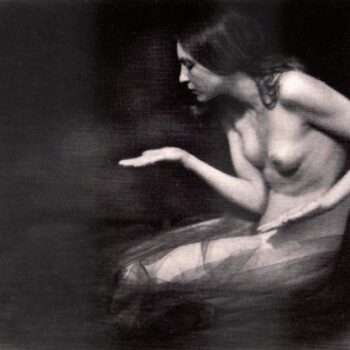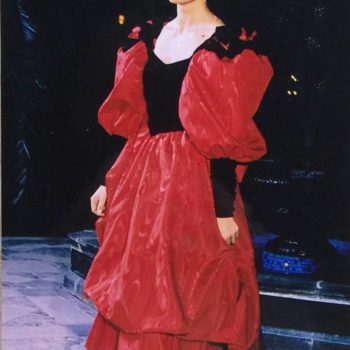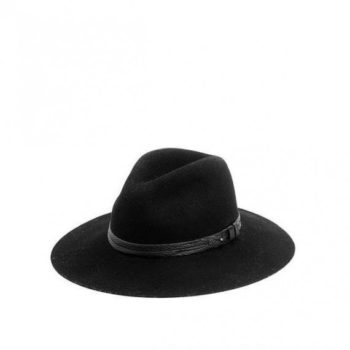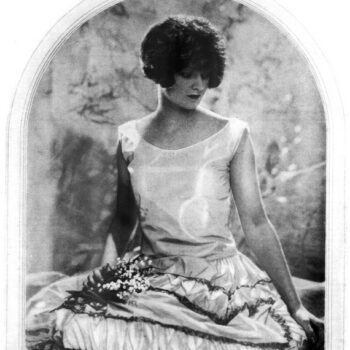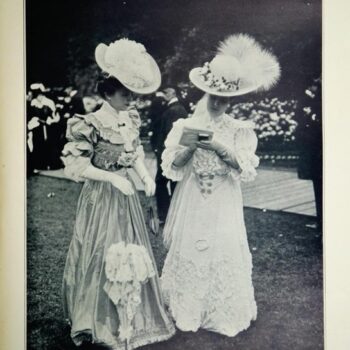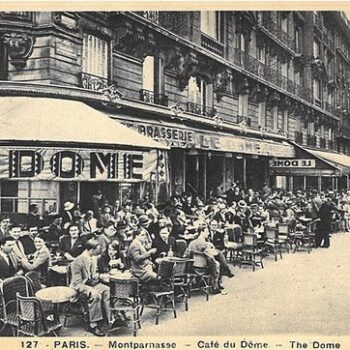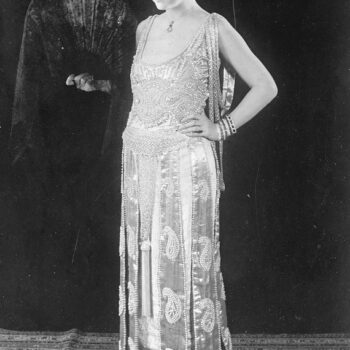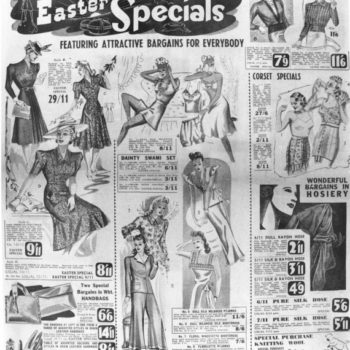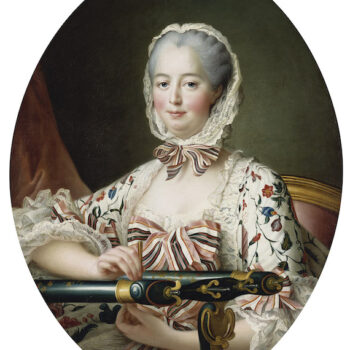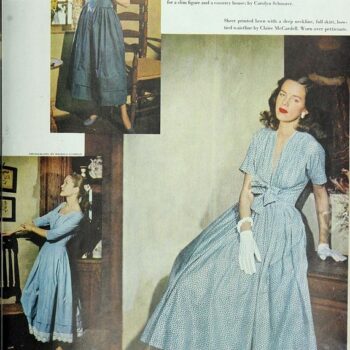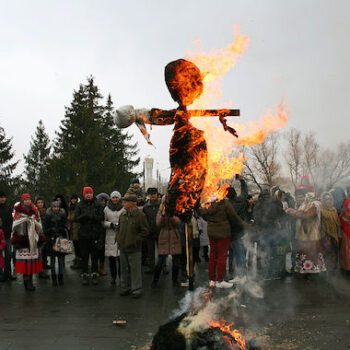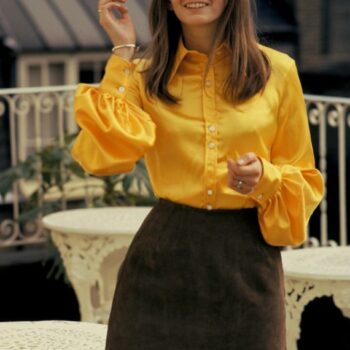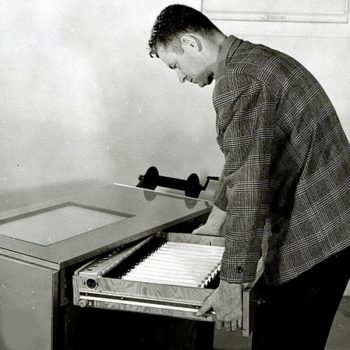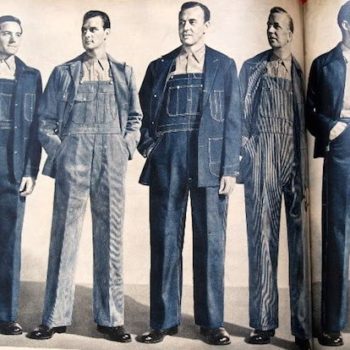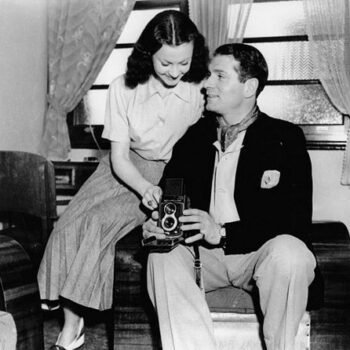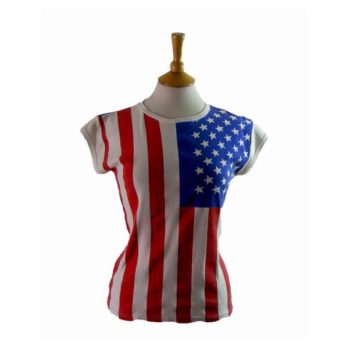Lady Ottoline Morrell – Socialite, Style Queen, and Person of Intrigue
October 19, 2024And a pair of boots stirred my interest in Ottoline Morrell. I saw them in an exhibition of Bloomsbury women’s gardens at the Garden Museum, which I failed to review because I couldn’t find any words about it. I couldn’t picture any of the gardens they were trying to bring to life. But these magnificently colourful calf length boots, which featured appliquéd red and green motifs including a bold pair of hearts, intrigued me.
On display was also a dress from Fortuny, but that on its own is not an unusual item. Also a rather dingy looking printed Indian jacket. Most women of 1920s or 1930s England didn’t wear Indian prints. But it was the boots and the information that Ottoline Morrell’s husband, Phillip Morrell, was a Conscientious Objector and the only MP to speak against the First World War in Parliament – with her full support – which made me want to find out more about her.
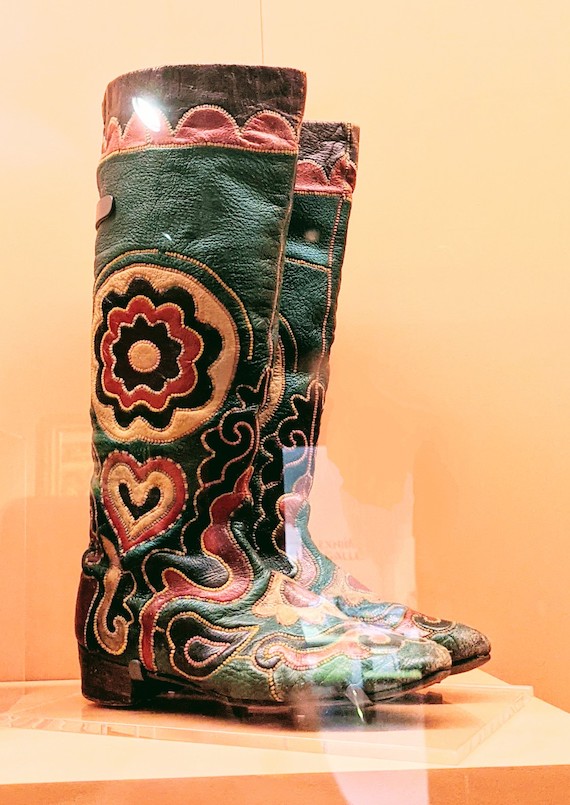
The boots. Image Genevieve Jones, taken at the Garden Museum. Object on loan from the Fashion Museum, Bath.
The Dubious Fame of the Bloomsburys
I am not actually a fan of the Bloomsbury Group as a whole. Virginia Woolf’s novels pass me by (although her journalism is engaging) and Vita Sackville-West’s novels are second-rate and derivative. Duncan Grant’s art is insipid and often poorly executed. Vanessa Bell’s art leaves me cold and I only ever picture her with a blank oval for a face, in the style of her own paintings. Possibly this is because she is consistently described as “the sister of Virginia Woolf and the wife of Clive Bell”.
I often wonder if their fame was because they were rich and noisy, willing to cross boundaries within the safety of their private incomes. About thier sex lives, the bisexuality and open marriages – well, the English upper classes are famous for having not-so-discreet lovers outside of thier often arranged marriages. And in some ways the reputation of the group of being sexually free became an expectation that may have been more a duty and burden than a joy for some.
Noble Lineage
But Lady Ottoline Morrell seems genuinely fascinating. Born in 1873, her first cousin was Elizabeth Bowes Lyon, the future Queen Mother. She did not claim to be an artist or writer or have any particular occupation or artistic calling. (Although she wrote private diaries and took from them to produce several volumes of memoirs, which were edited into two parts, one of which was published many years after her death to make sure no-one was alive to be hurt by some of her revelations).
She was a “Society Hostess”, who threw fantastic parties and “Weekends”, as well as welcoming some guests for longer, such as every summer for months on end, or whenever they liked. Certain of those repaid her incredible generosity by viciously making fun of her in letters (Virginia Woolf) or satirising her eccentricities in novels (D.H. Lawrence in Women in Love and Lady Chatterly’s Lover, Aldous Huxley in Crome Yellow, and at least ten others).
Six Foot Tall with Flaming Hair
What were Ottoline Morrell ‘s eccentricities? Well, for a start, she was six foot tall with flaming red hair and a really striking face. She was, perhaps, jolie laide, as some descriptions have her as beautiful but photographs and portraits regrettably don’t capture that. She also made her own clothes with the help of her maid. This was not completely unusual, but usually someone of her place in the world would go to Parisian couturiers or have a seamstress. What was unusual was that she made clothes to her own design, buying bolts of antique silk or ecclesiastical fabric to do so.
They followed, somewhat, the fashionable line of the day. So in the 20s they had dropped waists, in the 30s were bias cut. But they also wildly diverged and were inspired by the portraits of her Elizabethan ancestors, or her travels. She had a sumptuous dress up box of colourful embroidered silk clothes and shawls which she would encourage her guests to have fun with. But she also wore them for every day wear too – D.H. Lawrence, in Women in Love, describes her “wobbling down a ladder in enormous pink silk bloomers”. He is not talking about underwear, but Turkish trousers, which she found actually quite practical for climbing ladders in, and were one of her favourite items of clothing.
Ottoline Morrell – A Religious Libertine
She had, I think, decided to lean in to her unusual appearance. Her height and her hair didn’t really allow her to hide anyway. In fact she hennaed her hair and sometimes wore platform shoes with very high heels. As a child she was very shy, loved books and studying and was extremely religious. As a teenager she ended up giving bible classes to the men of the estate every Sunday. They were so popular that she had to do it twice, in two shifts. This indicates that she was probably good at it, despite the shyness which made the prospect of doing it in the first place very difficult. The classes, and answering questions afterwards, may have helped her to become a good host later on. Surprisingly, she remained very religious all her life, despite her libertine behaviour.
When she went to dancing classes in London with the other girls, she describes them whispering and sniggering, and herself as not knowing how to make friends. They were whispering about her clothes, even at that age. But she says she didn’t care, as they were “more fanciful and really far prettier than those worn by the others”. In Paris her mother had bought her “Some lovely muslin dresses” – very fashionable. Also “A row of pearls at the sale of the French Crown Jewels; she liked to feel that I should wear a row of pearls that had been round the neck of Marie Antoinette.”
Ottoline Morrell – Impractical yet Striking
She also didn’t seem to have a good grasp of practicalities. She was original, but also untidy. Her hair was always coming down, her button placket open, and her “skirt coming open below [her] band”. “My skirt and band failing to connect was a continual worry to me”. At that time, dresses were composed of separate parts. The skirt and bodice hooked onto a waistband, which presumably in her case wasn’t done up properly. Neither was her bodice at the front.
When she travelled to Italy as a young woman she wanted to take all her books with her. She tumbled them into a sack. Then, on further thought, she encased the sack in plush to make it prettier. She also constructed a matching red velvet travelling cloak. This she lined top to toe with pockets. They contained the books she wanted to keep close by to read on her journey. The result was a kind of armour plating. It was very heavy and gave quite a shock to anyone who bumped into her. The sack wasn’t easy to lift and transport, either. Why not a trunk and a handbag, I don’t know. But she seemed to have literally thought outside of the box on this one, as with many other things.
Ottoline Morrell – A Religious Libertine
As a child, she lived in a very unusual place. When she was six her half-brother became the Duke of Portland and she, Lady Ottoline. He inherited Welbeck, the ancestral home of the Portlands. This was a big empty building when they came to it, with all its grandeurs stashed away. Ottoline loved to crawl into the attics and gaze on the original ancient oil portraits that were stacked there, stripped of their frames. They were both royalty and her ancestors.
“My love of history was first stimulated by gazing at these old paintings, portraits of the courtiers of James I’s court, so elegant and lovely and sentimental, with pearls in their ears and long trailing lovelocks of golden hair hanging over their collars, and of ladies whom they loved, with very low cut dresses, showing pearly breasts, and embroidered skirts and exquisite shoes… portraits of the Countess of Essex who had poisoned Overbury; of Louis XIV… of Charles I… dressed in a green velvet doublet and skirt, with a sad pale face… of pale Arabella Stuart, who had been imprisoned nearby at Bolsover Castle. A small picture of Mary Queen of Scots, who soon became my dearest friend – the exquisite face with a pearl drop on her forehead, and a fine gold cap over her small head – I used to visit very often.”
Tasselled Robes
She would drag the red velvet and gold tasselled robes that she found out of old chests, and twirl in them. Her brother, going through the drawers of a piece of dust-sheeted furniture one day while someone held a candle for him, came upon a green silk purse full of wads of money – a fortune in cash. Ottoline was given the purse, minus the money, and was very happy with it.
What was even more unusual about this building was that it had huge underground tunnels built to access it. They were big enough for a carriage and horses to ride comfortably, lit with skylights as well as gaslights. There were also underground tunnels for the servants to bring meals up to the few uninhabited rooms. And an enormous underground riding school, done up like a ballroom.
It could have been that Ottoline’s uncle was as eccentric as she was. But it was also rumoured that constructing these massive works was a way to provide employment to the local village in a time of high unemployment. Or maybe a bit of both. The uncle treated his employees very well, keeping a school of donkeys to fetch them from the village every day, and in turn, keeping the donkeys very well fed and happy too. If he came upon a serving maid, he would, it was said, immediately send her out for a turn around his private ice skating rink, whether she wanted to or not.
Ottoline Morrell – A Religious Libertine
Ottoline also had a tremendous respect for the working classes, and was very distressed when D.H. Lawrence satirised them as well as her in Women in Love. She was concerned for their welfare, as well as all of the young men sent off to the first world war. She gave many people of all classes shelter and employment on her home farm at Garsington Manor, a 16th century mansion where she and her husband had moved in 1913. Farm work provided exemption from being called up to the war. As a land owner she was not indifferent to the land itself either, and loved nature, working on the farm herself and often urging her guests to do so as well. She would point out daffodils and butterflies on the way, which they privately complained about.
Ottoline was very intelligent, and very interested in books and theories. She had briefly attended university in Scotland. Unfortunately the extreme cold exacerbated a life long illness that she suffered from and she had to leave. She also travelled widely, both before marriage, partly in order to treat her illness, and after. Unfortunately as a hostess she was reduced to listening and making encouraging noises. ‘But sometimes I used to feel hurt when people came [to Garsington] and did not take any trouble to talk to me, but just amused themselves and ignored me. When I was talking to Gilbert Cannan one day I said that I felt that the young people who came looked on me as a sort of kind of manageress of a hotel, and rather took me aback by saying “Of course, we do.”’ She wrote in her memoirs.
Ottoline Morrell and D.H. Lawrence’s reconciliation
Ottoline and DH Lawrence reconciled at the end of both of their lives. When both were very ill, he wrote to her:
“But Ottoline has moved men’s imagination, deeply, and that’s perhaps the most a woman can do. And in the world today, full of women, how rare to find one that can move the imagination! No, I wish, and wish deeply, there could be Ottoline again and Garsington again, and we could start afresh.”
Lady Chatterly’s Lover
Although Ottoline often slept with her guests at the end of the evening as a kind of extra flourish, she did not especially enjoy it. A long-time affair with Bertrand Russell seemed to be an unfortunate and rather wearisome entanglement on her part. She confided to her diaries that she didn’t fancy him. Her one true exciting fling was with Tiger, a stone mason. It only lasted a few months as he died in her arms due to a head injury. This love affair was the model for Lady Chatterly’s Lover. Both of these books are turgid and not recommended. If you want to know what life was like at Garsington, you could read Aldous Huxley’s Chrome Yellow, which was written while he lived there. It’s accurate, though unkind, and he scarcely bothers to change the names or identities of the guests who are present.
Ottoline Morrell was a fascinating, original woman. I think it’s time to enjoy her unusual life and take inspiration from her free spirit.




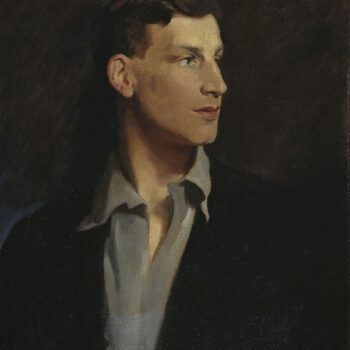
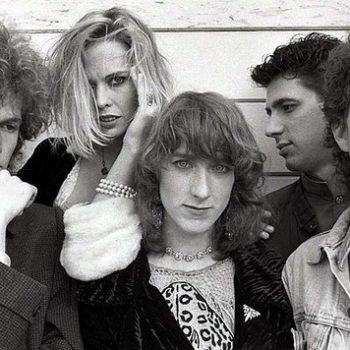
![fashion style icons.Audrey_Hepburn.(https://creativecommons.org/licenses/by-sa/4.0)], via Wikimedia Commons](https://www.blue17.co.uk/wp-content/uploads/2017/04/570px-Audrey_Hepburn_auf_dem_Bürgenstock_09-350x350.jpg)
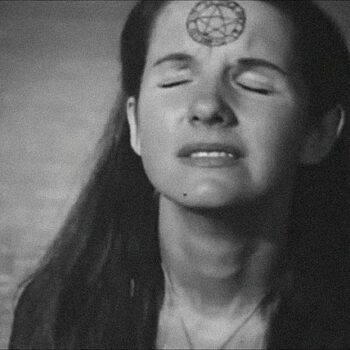
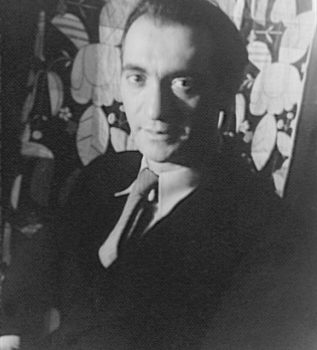
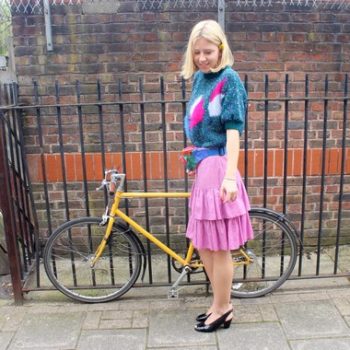
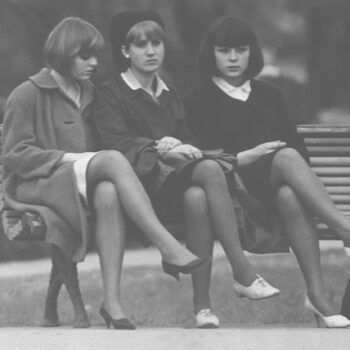
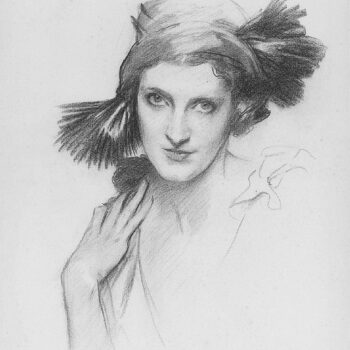
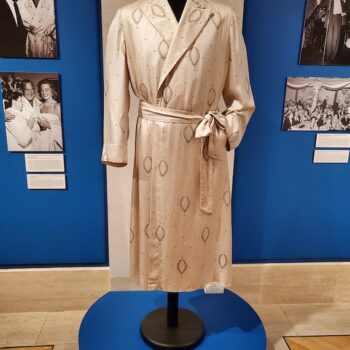

![Teresa Collenette and the Secret Life of Scissors, Creatures_by_Hannah_Hoch,_1926-1929,_oil_on_canvas_-_Germanisches_Nationalmuseum_-_Nuremberg,_Germany_By Daderot [Public domain or CC0], from Wikimedia Commons](https://www.blue17.co.uk/wp-content/uploads/2018/05/Creatures_by_Hannah_Hoch_1926-1929_oil_on_canvas_-_Germanisches_Nationalmuseum_-_Nuremberg_Germany_-_DSC02365-350x350.jpg)
